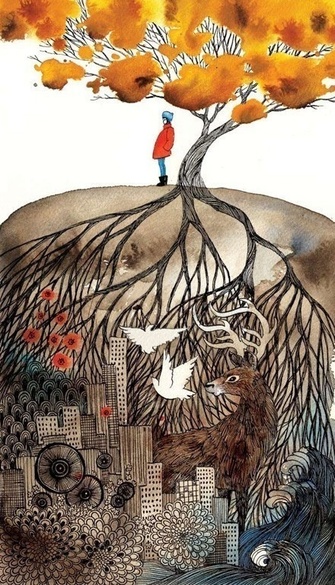The twelve principles of permaculture - interpreted for childhood education
OBSERVE AND INTERACT
"Beauty is in the mind of the beholder"
|
As each child is unique, each one will flourish with a different approach to teaching. What works for some, may not work so well for others. Pay attention to each individual child closely, and by recognising the beauty and magic in each child with their own particular gifts and strengths you can develop your own best method of working together.
CATCH AND STORE ENERGY
|
OBTAIN A YIELD
"You can't work on an empty stomach"
Remember that yields come in all shapes and sizes- often it is only the material things that can be measured and counted, which many mainstream schools focus on. But time spent in free play, imagination, creativity, positive interactions with others, self expression and enjoyment are all very valid and beneficial yields. They create strong and lasting benefits for the participants, which then go on to enhance all other parts of their lives. Definitely worth looking out for.
APPLY SELF-REGULATION AND ACCEPT FEEDBACK"The sins of the fathers are visited on the children of the seventh generation"
Remember to always be ready to re-adjust or change completely lesson plans to fit with what is naturally occurring, in order to maximise the free flowing energy within the group. Pay attention to what the children are saying with their behaviour, and if something is just not working, bring in a different approach to share the message you are trying to convey. And if it all goes horribly wrong, there will always be a next time. Writing notes on the lesson plan at the end of a class can really help to keep a track of what worked and what didn't, so that it can then be changed for the next time around.
USE AND VALUE RENEWABLE RESOURCES AND SERVICES"Let nature take it's course"
Nature is by far the greatest teacher in any child's life. Unfortunately, in the day to day life of many children today they spend so little time outdoors that they are losing that connection and their ability to listen to the wisdom and inspiration that comes from natural sources. Nature reconnection and awareness activities are vital to restore that harmony, and play a huge part in sharing permaculture with children.
|
PRODUCE NO WASTE
"Waste not, want not"
So many activities can be done using recycled, reclaimed and natural materials, there should rarely be a need for buying new resources. When there is, try to always buy from ethical sources. Your children (and their parents) are influenced in many ways and subtle things like that can have a huge impact.
DESIGN FROM PATTERNS TO DETAILS"Can't see the forest for the trees"
Be aware of slipping into old or negative patterns of behaviour when it comes to the way you are interacting with your children. Even with the best intentions, it takes a lot of conscious thought to maintain a high level of awareness and patience with a class. Be aware of your behaviour, and if you find yourself slipping, take a few moments out to catch yourself. Take yourself out of the situation for a moment, take a few deep breaths, and return when you feel able to handle the situation in a way that you would choose to.
INTEGRATE RATHER THAN SEGREGATE"Many hands make light work"
Remember that it's not only the subject that you are sharing that is a learning experience for the child, but also your behaviour and way of interacting that influenced them as well. Stack functions into classes with being aware of your presence in the class; being a positive role model at all times. Children learn through imitation, and so guide them well by maintaining communication filled with openness, honesty, respect and open mindedness.
|
USE SMALL AND SLOW SOLUTIONS
"Slow and steady wins the race"
Remember the gradual process of learning - and don't try to make too huge a leap without making sure everyone is following with the depth of understanding necessary to fully comprehend the topic. Many of the concepts connected with permaculture involve developing and/or coming to an understanding of a persons own connection to nature or society around them, and can take some time to be able to allow these inner feelings through clearly. Sometimes shifts can be occurring on an internal level that we may not see immediately on the outside.. This is whole life learning, so be aware that huge progress does not have to be seen within one class or course, to get the thought processes started and on the way can be plenty for the child's stage of development.
USE AND VALUE DIVERSITY"Don't put all your eggs in one basket"
Remember that each child is a complete individual, with his own likes, dislikes, and particular learning styles. Be receptive to each of these, and create lessons that contain a range of techniques so that each of these learning styles can be supported equally. A child's individuality is the magic that makes him or her who they are, and should be celebrated, nurtured and protected.
USE EDGES AND VALUE THE MARGINAL"Don't think you are on the right track just because it's a well beaten path"
Children relish being introduced to and guided into activities that push their edges, things that they cannot yet do but would like to be able to. They are incredibly fast learners and with the right support to assure them that they can be successful, they can often accomplish things that they (or their parents) never thought possible.
|
CREATIVELY USE AND RESPOND TO CHANGE
"Vision is not just seeing things as they are but as they will be"
With any activity or concept you are introducing, be ready to adapt or shift the plan with the needs of the group. If things aren't getting through and it's a lovely day, take the class outside and adapt your activities to suit.
You can return to the main project page here




